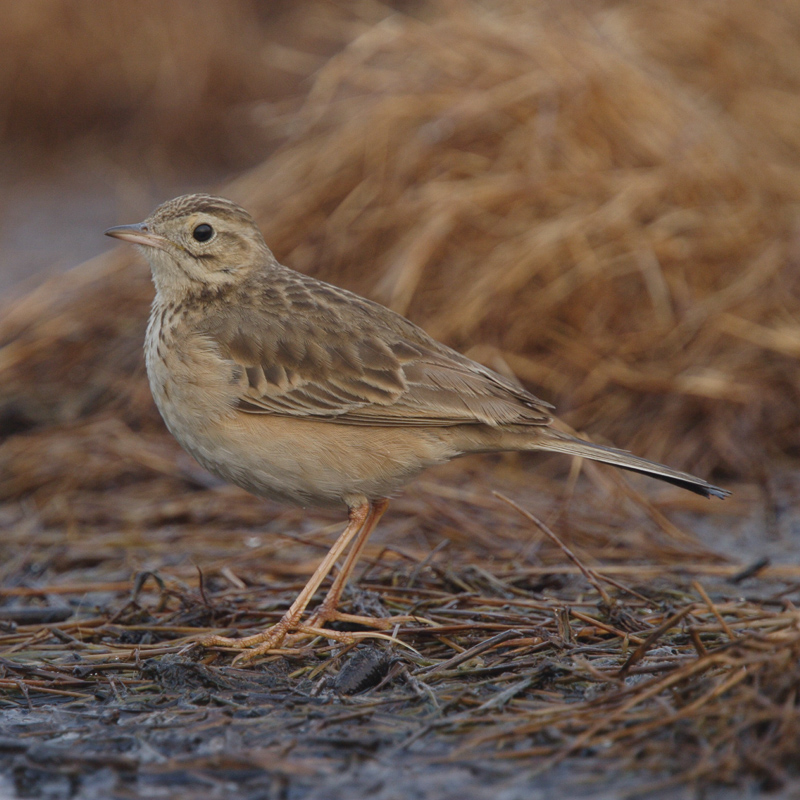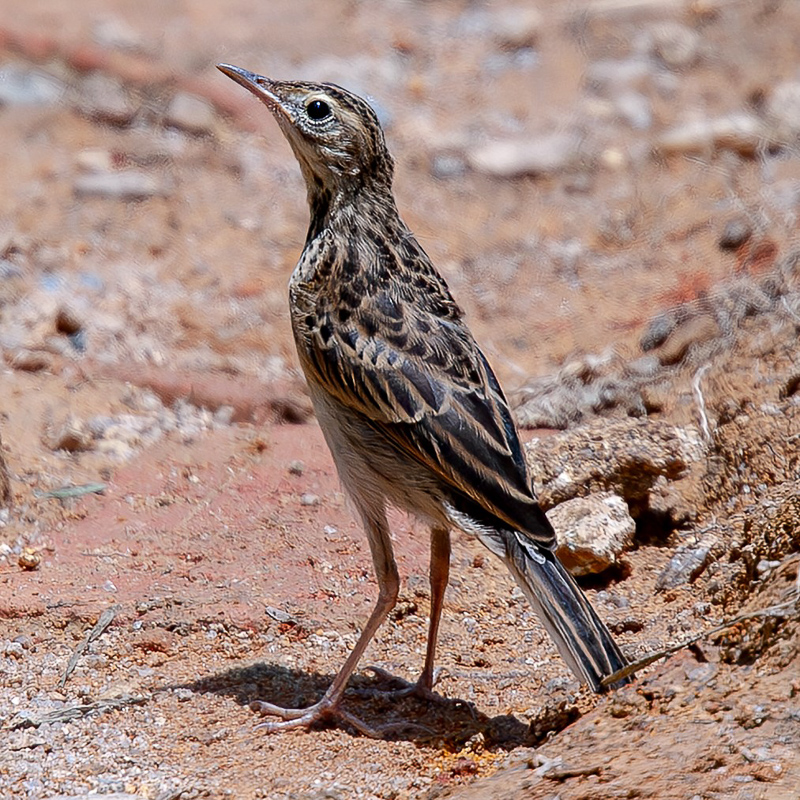Richard’s Pipit Anthus richardi 理氏鷚
Category I. Common passage migrant and winter visitor to lowland open-country areas with grass; localised breeding species in grassland, usually in hills.
IDENTIFICATION

Apr. 2006, John and Jemi Holmes.
17-18 cm. Large, long-legged pipit with noticeably long hind claw. Bill large (foreshortened on this bird) and often held slightly raised. Lores pale, supercilium buff but poorly-marked, moustachial and malar stripes narrow and dark brown. Brown on upperparts, pale buffish or whitish below with distinct streaks on chest. White in outer tail feathers. Note shape and colour of median covert tips.

Jun. 2006, Michelle and Peter Wong. A. r. sinensis, juvenile.
This juvenile of the locally-breeding subspecies A. r. sinensis shows the broad buff fringes (slightly whiter around the tip) feathers of fresh plumage.
VOCALISATIONS
The typical flight call is a loud and harsh ‘shreep’. This recording is of a wintering bird.
This recording is of a bird calling on the breeding grounds.
The song is a simple phrase repeated in song flight at short intervals: ‘chuchuchuchuchuchu’.
DISTRIBUTION & HABITAT PREFERENCE
Migrants during passage and in the winter favour grassy habitats in widespread and diverse lowland areas, though densities are highest in pure grassland such as that on airfields.
Since 1999 breeding season records have come from grassy areas of the airfield at Chek Lap Kok (though not since 2010), Heung Yuen Wai, Kai Tak, Lamma, Ping Fung Shan, Robin’s Nest and Tai Mo Shan. Up to the end of the 1990s breeding records also came from Pat Sin Leng, Kowloon Peak, Sunset Peak and Castle Peak, as well as coastal areas around outer Tolo Harbour.
During the 1993-96 breeding bird survey Richard’s Pipit was recorded in 9.6% of 1km squares, while in the 2016-19 survey it was only recorded in 2.7% of squares. The main declines occurred in the western New Territories, Sai Kung and on Lantau, probably due to vegetative succession replacing grassland with shrubland-grassland or shrubland habitats. A similar decline was also noted for Upland Pipit.
During the winter atlas survey of 2001-05 Richard’s Pipit was recorded in 12.4% of 1km squares, while in the 2016-19 survey this figure had reduced to 5.1%, indicating a substantial diminution in distribution. The decline appears to have occurred in widespread areas but was most noticeable in the west New Territories, east Lantau, Lam Tsuen, either side of outer Tolo Harbour, Sai Kung and the Clearwater Bay peninsula. It is likely that vegetative succession to grassland-shrubland or shrubland has contributed to this decline, and possibly also loss of village-edge habitats.
OCCURRENCE
Migratory populations of Richard’s Pipit occur from at least mid-September to mid-May, with highest numbers occurring on autumn passage in October and November, peaking in the final three weeks of October (Figure 1). The wintering population remains relatively stable until the end of February, while spring migration is apparent from the middle of March, falling sharply at the end of April. Low numbers of breeding birds are present in the summer months.
Studies at the former airport at Kai Tak during 1974-79 (Melville 1980) showed that birds were usually present from the first week of September through to the last week of May, with an increase during passage periods, especially in early April (although the highest single-site count recorded in HK was 93 on 4 May 1979), and the last week of September through to the third week of November, peaking during the second and third weeks of October (high counts of 91 on 6 October 1978 and 102 on 12 October 1979).
Since 1999 highest numbers have generally been recorded on the airfield at HK International Airport, with the highest being 75 on 24 October 2008. Elsewhere, highest counts are 60 at Long Valley, 46 flying south at Mai Po NR and 43 at Kau Sai Chau.
Both Kershaw (1904) and Vaughan and Jones (1913) refer to Richard’s Pipits as being very common winter visitors, occurring from the end of September to the end of May; the latter stated that it ‘presumably nests’ in HK in small numbers. Herklots (1953, 1967) also referred to its being a passage migrant, seen from the end of August to the third week of May, and that it was a regular summer visitor.
BEHAVIOUR, FORAGING & DIET
Usually recorded feeding on insects or plant seeds, it was once recorded eating bread (Melville 1996). Walks in a rather upright fashion through grassy vegetation as it forages. Song is delivered in flight.
BREEDING
Since 1999 birds in song have been noted in suitable breeding habitat from 22 March to 30 May. Carrying food to the nest was noted on 21 April, while dependent juveniles were recorded on 11 August. At the former airport at Kai Tak a juvenile almost able to fly was seen on 8 October 1975 and a pair was seen with two young on 7 June 1961 (Melville 1980).
RANGE & SYSTEMATICS
Monotypic. Breeds in south and southeast Siberia south through Mongolia to much of north and east and southeast China; winters from coastal south China through Indochina to much of the Indian subcontinent (Tyler 2020). In China breeds in the northwest, north and northeast as far south as Shandong and winters in south coastal provinces (Liu and Chen 2020).
CONSERVATION STATUS
IUCN: Least Concern. Population trend stable.
Figure 1.

Herklots, G. A. C. (1953). Hong Kong Birds. South China Morning Post, Hong Kong.
Herklots, G. A. C. (1967). Hong Kong Birds (2nd ed.). South China Morning Post, Hong Kong.
Kershaw, J. C. (1904). List of birds of the Quangtung Coast, China. Ibis 1904: 235-248.
Liu, Y. and Y. H. Chen (eds) (2020). The CNG Field Guide to the Birds of China (in Chinese). Hunan Science and Technology Publication House, Changsha.
Tyler, S. (2020). Richard's Pipit (Anthus richardi), version 1.0. In Birds of the World (J. del Hoyo, A. Elliott, J. Sargatal, D. A. Christie, and E. de Juana, Editors). Cornell Lab of Ornithology, Ithaca, NY, USA. https://doi.org/10.2173/bow.ricpip1.01
Melville, D. S. (1996). Richard’s Pipit eating bread. Hong Kong Bird Report 1995: 251-252.
Melville, D. S. (1980). The birdstrike problem at Kai Tak Airport, Hong Kong. Final summary report 1974-1979. Agriculture and Fisheries Department, Hong Kong.
Vaughan, R. E. and K. H. Jones (1913). The birds of Hong Kong, Macao and the West River or Si Kiang in South-East China, with special reference to their nidification and seasonal movements. Ibis 1913: 17-76, 163-201, 351-384.

